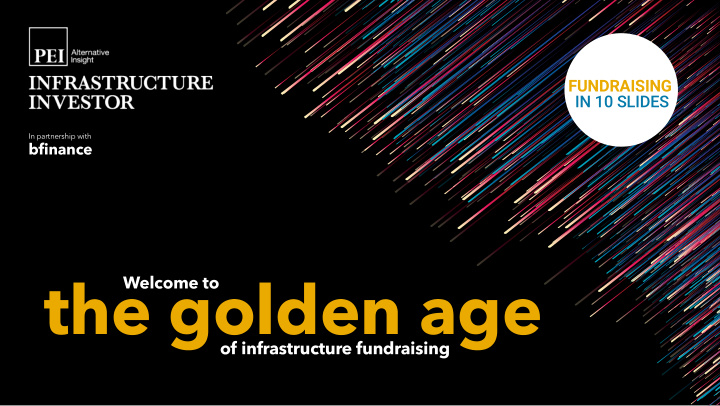



FUNDRAISING IN 10 SLIDES In partnership with bfinance Welcome to the golden age of infrastructure fundraising
Click here to read more A record year... With three months left, fundraising is already ahead of last year, making 2018 the biggest year for the asset class 70 110 60 94 In terms of the concentration 50 79 Number of funds closed of capital being Capital raised ($bn) sought, it ’ s quite 40 63 unprecedented James Wardlaw, 30 47 head of infrastructure, Campbell Lutyens 20 31 10 16 0 0 2011 2012 2013 2014 2015 2016 2017 YTD 2018 Capital raised ($bn) Number of funds closed Source: Infrastructure Investor
Click here ... but 2019 threatens to be even bigger to read more There's a decent chance next year will end up at $100bn raised, considering some of the market's biggest names are back on the fundraising trail Five of the biggest potential fund closes in 2019 $60bn bonanza If all these five funds hit a final 2014 close next year they will have raised as much as 88 funds did in 2014. Quick close? 2019 Rumour has it GIP's fourth flagship fund is due to close in early 2019, driven in part by a strong re-up rate from existing investors. 0 5 10 15 20 25 30 35 40 45 50 55 60 Crossing the pond Capital raised ($bn) French fund manager Antin is said to be eyeing more investments in Brook fi eld Infrastructure Fund IV Global Infrastructure Partners IV EQT Infrastructure IV Antin Infrastructure IV Ardian Infrastructure IV North America, as its latest vehicle is set to grow in size by 38%. Total Source: Infrastructure Investor (2019 values are an estimate only)
Click here to read more Has debt fundraising peaked? Infrastructure debt funds have collected $43bn globally since 2013, peaking at more than $12bn in 2015 12 17 10 14 Subordinated Number of funds closed debt is catching 8 11 Capital raised ($bn) investors' attention, particularly 6 8 investors that do not have liability-matching 4 6 requirements Anish Butani, 2 3 director, private markets, bfinance 0 0 2013 2014 2015 2016 2017 YTD 2018 Capital raised ($bn) Number of funds closed Source: Infrastructure Investor
Click here to read more No Trump infra plan? No problem North America continues to lead by regionally dedicated funds in market, but it was Asia that captured the attention of one of the largest vehicles closed this year, the Macquarie Asia Infrastructure Fund II Funds in market Top 10 funds closed YTD Size KKR Global Infrastructure Investors III $7.4bn Stonepeak Infrastructure Fund III $7.2bn ISQ Global Infrastructure Fund II $7bn Copenhagen Infrastructure Partners III $4.1bn Macquarie Asia Infrastructure Fund II $3.3bn Macquarie Super Core Infrastructure Fund $2.93bn Partners Group Direct Infrastructure 2016 $2.58bn Infracapital Partners III $2.5bn InfraVia European Fund IV $2.32bn LS Power Equity Partners IV $2.25bn Source: Infrastructure Investor $0bn $5bn $10bn $15bn $20bn $25bn $30bn $35bn $40bn $45bn $50bn $55bn Source: Infrastructure Investor
Click here to read more How much does an infra strategy cost? Fee data from bfinance on 50 managers in market since 2016 shows value-add strategies are the costliest, with core/core+ offering the cheapest entry point to the asset class 22 20 19 18.6 18 16 At a strategic level, 14 14 investors are very Mean (%) hungry to allocate 12 to the asset class. 10 We are very much 8 8 in a manager ’ s 7.5 7 market as far as 6 fees are concerned 4 Anish Butani, director, private markets, 2 bfinance 1.5 1.4 0.9 0 Core/Core+ Core+ Value-add Management fee Hurdle Carry Source: bfinance (sample size: 42 funds; 6 out of 8 core managers charge carry)
Click here to read more What about funds of funds? Newcomers to the asset class might find these structures appealing. But while they seem cheaper, investors should bear in mind the impact of underlying management and performance fees on overall returns when allocating Overall fees Vehicle fees 4.0 Management fee 3.5 3.5 0.54 3.0 2.5 Mean (%) Hurdle 7.13 2.0 2 1.5 1.0 Carry 9.75 0.54 0.5 0 0 1 2 3 4 5 6 7 8 9 10 11 Base fee Underlying fees Total estimated fees (inc. fees on fees) Mean (%) Source: bfinance (sample size: 8 funds) Source: bfinance (sample size: 8 funds)
Click here Sticky terms to read more Even established managers charge fees on committed capital, underlining we are in a seller's market, while catch-up is still private-equity like Catch-up Fees on committed capital 100 91 90 82 80 No fee 28% 70.5 70 67 60 Mean (%) 50 40 30 20 Charges fee 72% 10 0 Core/Core+ Core+ Value-add FoFs Source: bfinance (sample size: 50 funds) Source: bfinance (sample size: 50 funds)
Click here Mind the cost build-up to read more When all expenses are considered, fee leakage shows costs that are not always factored in to the gross-to-net IRR spread Gross & net IRR Fee leakage 5.5 Leakage in core 5.1 Core/core+ 5 funds can be high as a proportion of 10 8.5 4.5 gross IRR. It ’ s not 4 uncommon to see core managers 3.5 3.3 charge an all-in Core+ Mean (%) 3 12.8 10.7 expense ratio of 2.5 2% – that ’ s 20% of returns on 2 a fund targeting Value-add 1.5 1.5 10% gross 17.3 13.5 1 Anish Butani, director, private markets, 0.5 bfinance 0 5 10 15 20 25 30 0 Mean (%) Core/core+ Core+ Value-add Source: bfinance (sample size: 42 funds) Source: bfinance (sample size: 42 funds)
In partnership with bfinance This report was compiled from data collected for Infrastructure Investor 's In Focus: Fundraising published in October 2018. Bruno Alves Senior Editor Infrastructure Investor bruno.a@peimedia.com +44 (0)207 167 2031 Patrick O'Donnell Production Editor Infrastructure Investor patrick.o@peimedia.com +44 20 566 5465 Design: Miriam Vysna
Recommend
More recommend